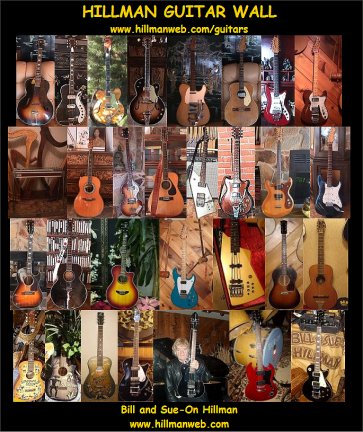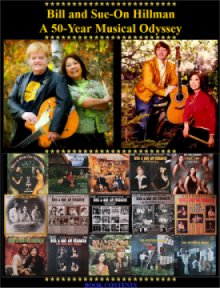Harmony
Monterey Sunburst
Archtop Acoustic Guitar
www.hillmanweb.com/guitars/g01.html
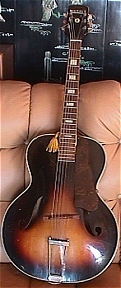 This
was my first guitar. Actually it was my Dad's guitar. I believe he bought
it at Ray Hamerton Music in Winnipeg in the early '50s. Hamerton's used
to send out an annual catalogue of their musical instruments and supplies
and I remember spending many hours poring over this. Even though my Mom
and Dad had regular jam sessions throughout the '50s, he never really played
it much, preferring to play the trumpet while my Mom played piano. I started
taking piano lessons while in Grade V or VI and the whole process was largely
one of drudgery. But I remember that I used to open the fibre case that
housed the shiny archtop and marvelled at its beauty - the shape, the smell
and the feel of it. I had been committed to the discipline of piano lessons,
however -- and often fell under the wrath of my frustrated piano teacher
when I showed up without having practiced the assigned lessons.
This
was my first guitar. Actually it was my Dad's guitar. I believe he bought
it at Ray Hamerton Music in Winnipeg in the early '50s. Hamerton's used
to send out an annual catalogue of their musical instruments and supplies
and I remember spending many hours poring over this. Even though my Mom
and Dad had regular jam sessions throughout the '50s, he never really played
it much, preferring to play the trumpet while my Mom played piano. I started
taking piano lessons while in Grade V or VI and the whole process was largely
one of drudgery. But I remember that I used to open the fibre case that
housed the shiny archtop and marvelled at its beauty - the shape, the smell
and the feel of it. I had been committed to the discipline of piano lessons,
however -- and often fell under the wrath of my frustrated piano teacher
when I showed up without having practiced the assigned lessons.
THEN Elvis
and Sun Records appeared on
the scene. And Dad came home excited one day after hearing a song on the
car radio that featured one of the few riffs he knew on guitar. The
song turned out to be Johnny Cash's I Walk The Line, with the whole
song made up around Luther Perkin's guitar runs between C, F and G. That
was it. Boring scales and kiddie tunes on the piano didn't stand a chance
when pitted against the exciting sounds of this new thing called
rock 'n' roll - and especially the guitar sounds coming out of Memphis
on Sun records. I was totally captivated. Countless hours were spent roaming
the radio dial to pick up each week's new rockabilly and R&B barrage
of hits that emanated from the Southland.
My Uncle Don, had played guitar with my Mom
and their brother, Bill, in the family band -- The Campbell-Christie Orchestra
-- back in the '30s. They were just young kids but they joined forces with
a couple of neighbor buddies and played quite a number of dances at halls
and barns around the area (guitar, piano, autoharp, trumpet, fiddle, accordian,
etc.) When Uncle Don saw that I was more than a little obsessed with the
instrument, he showed me a few more chords and how to play a few folk songs.
I soon found that mastering this instrument
was no easy task. It was hard to tune and the strings were so high above
the fretboard that I could barely press them down. My fingers soon became
raw and blistered and often bled, but I persisted.
It was around this time that I got my first
record player and LPs for Christmas. Previous to this all we had to play
records on was a 78 rpm turntable plugged into our huge floor model Westinghouse
radio. The first 78s I had bought for this old machine were a package of
50 Top Hits of the Day (by imitators) with three hits per side, and then
a flood of REAL records: Elvis and the Blue Moon Boys, Fats Domino, Jack
Scott, Johnny Cash, Little Richard, etc. But now with my new RCA multi-speed
portable record player I could at last buy LPs and those cool 45s. I could
also slow the records down to half speed so that I could figure out what
Scotty Moore, Carl Perkins, Luther Perkins, Duane Eddy, Les Bennetts (Lonnie
Donegan's skiffle group), Chet Atkins, et al, were actually doing on those
great records.
With a little prompting from her grandson with
the bleeding fingers, my Grandmother soon realized how important it was
that her young boy should have an electric guitar: Enter the Sears black-with-gold
fleck, Les Paul-shaped, Silvertone
electric guitar. (Ironically made by Harmony)
Hillman Guitar No. 2
Silvertone
Sears made by Harmony
www.hillmanweb.com/guitars/g02.html
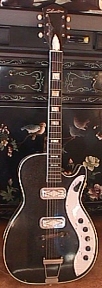 Yahoo!
A hot summer day in Strathclair, 1960. I took a walk over to the hardware
store that Dad managed (a new career to offset last year's disaster when
our crop was hailed out) to take a lunch break from my summer painting
job. A parcel from Simpson-Sears mail order had just been delivered --
my first electric guitar . . . and amp: a Sears Silvertone made by Harmony.
It was a gift from my Nannie Campbell - the first of numerous guitars she
would help me acquire.
Yahoo!
A hot summer day in Strathclair, 1960. I took a walk over to the hardware
store that Dad managed (a new career to offset last year's disaster when
our crop was hailed out) to take a lunch break from my summer painting
job. A parcel from Simpson-Sears mail order had just been delivered --
my first electric guitar . . . and amp: a Sears Silvertone made by Harmony.
It was a gift from my Nannie Campbell - the first of numerous guitars she
would help me acquire.
Sitting in the family 1960 blue Pontiac in
the lane behind the store, I tore open the box. It was a beaut! . . . shiny
black finish with metallic speckles and white trim. And that neck and fingerboard!
The strings lay almost against the frets . . . no effort to play. I remember
that the first thing I played on it was a low string "Honky Tonk" blues
riff I had learned from a kid at Air Cadet Camp in St. Jean, Quebec, earlier
that summer. This is day I will never forget . . . I still have the box
it came in.
Now I could join in the family jams and be
heard. At about this time my mom and uncle were talking about getting together
with members of the Christie family for a Campbell-Christie Orchesta reunion.
This reunion in the Municipal Hall where they had played many times back
in the '30s, turned out to be my first appearance on stage with a guitar.
Now I was ready to ditch those piano lessons.
I've learned since that many other guitarists
who went on to major careers also had a similar experience with this model.
It is a popular vintage guitar now in rock and country videos . . . Neil
Young . . . Bryan Adams . . . and many others have paid tribute to it on
stage and in interviews. I remember once a few years after when my Gretsch
had been stolen, my rhythm player offered to lend me his Strat for a major
show . . . but I just couldn't get used to the feel of it and decided to
use my old friend, Silvertone, instead.
This was the guitar I took with me to Brandon
College in the fall of '61 . . . a real companion for a homesick farm kid
away from home for the first time.
Hillman Guitar No. 3
Gretsch Nashville
Serial No. 47562 (1962)
www.hillmanweb.com/guitars/g03.html
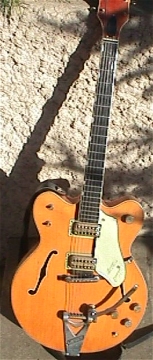 My
Silvertone guitar was a constant companion during my first year at Brandon
College, so word started to get around that I was some kind of guitar player.
Gradually I started jamming with other musicians and bands: folk, jazz,
rock, country, etc. One of the bands had a TV show, but had experienced
a bit of a breakup. A classmate in the college dorm, fiddler Barry
Forman, had kept the rights to the band name - the Country Gentlemen
- as well as the contracts that went with it. Before long, Barry and I
were rushing from morning classes every day to reach the CKX-TV studios
in time for a daily TV noon show. [See
The Country Gentlemen Years] I was expecting to play rhythm guitar
on this largely unrehearsed show but on the first day found myself doing
lead guitar solos. It was time for a more professional guitar.
My
Silvertone guitar was a constant companion during my first year at Brandon
College, so word started to get around that I was some kind of guitar player.
Gradually I started jamming with other musicians and bands: folk, jazz,
rock, country, etc. One of the bands had a TV show, but had experienced
a bit of a breakup. A classmate in the college dorm, fiddler Barry
Forman, had kept the rights to the band name - the Country Gentlemen
- as well as the contracts that went with it. Before long, Barry and I
were rushing from morning classes every day to reach the CKX-TV studios
in time for a daily TV noon show. [See
The Country Gentlemen Years] I was expecting to play rhythm guitar
on this largely unrehearsed show but on the first day found myself doing
lead guitar solos. It was time for a more professional guitar.
Barry's mentor and great supporter of local
musicians back in his hometown of Rivers was Alex Whyte. Mr. Whyte offered
to order a Gretsch guitar -- wholesale -- and before long I was the proud
owner of an orange, double cut-away, Chet Atkins model, Gretsch Nashville
-- paid for again by my greatest supporter: my grandmother, Katie
Campbell.
This soon led to a very busy and confusing
schedule as I my college classes took a back seat to my rehearsals and
playing with an endless variety of bands: Co-Op Neighbour Nights on TV
and in person, Flamingo Jazz Combo, Blue Angels (4 hours of rock lead guitar
each night), the Shadows and Dovermen rock bands, road tours, and freelancing
for a multitude of other gigs around Manitoba. [See The
College Years 1961-1965] The Gretsch proved to be a great guitar for
many different styles of music. By this time I had upgraded my first Sears
amp to a much larger Harmony amp, but my dream was to save enough money
to buy one of the new Fender Twin Reverbs. It seemed that the only place
the red-haired guy with the orange Gretsch guitar didn't turn up at was
the college classroom.
When not playing I hung out at the Brandon
Roller Rink where the owner brought in a constant stream of touring bands
from the States: Ventures,
Conway Twitty, Dorsey Burnett, Johnny Burnett, Jimmie Gilmer and the Fireballs,
black blues bands, etc. I had the satisfaction of seeing that none of the
touring or local musicians I saw had a guitar like mine. The closest thing
to it was the thick single cutaway 6120 red Gretsch used by Winnipeg's
Randy Bachman of Chad Allan
and the Reflections. This was probably my favourite band of the time.
Randy used the playback/monitor head of a reel-to-reel tape recorder to
get a great echo delay sound which was so vital in achieving their English
Shadows instrumentals. The band played Brandon regularly and we got to
know them all quite well. By this time I had acquired many wholesale musical
catalogues through my Dad's hardware business and Randy had even asked
about getting a new Gretsch wholesale. This association with Winnipeg musicians
proved to be quite beneficial in many ways in years to come and when we
started to tour ourselves. [See The
Early Rockin' Years].
In 1965, my ruddy, six-stringed buddy and I
were separated under disastrous circumstances. It happened after a freelancing
gig I had played with a pickup band in McCreary Hall. The band leader/driver
was invited to a small party after the dance so the rest of the band had
to go along, reluctantly leaving our gear in a not-very-secure old station
wagon. We were soon on our way home however, stopping at Neepawa to drop
off our bass player. It was only then we discovered that all our gear had
been taken from the back of the wagon . . . including my Gretsch and stage
clothes. We reported the theft to the RCMP, but I didn't hold much hope
that I would ever see my guitar again.
I was prepared to use my old Silvertone for
a long time to come when my parents and ever-understanding grandmother
came to the rescue. We made some rush calls to music wholesalers. There
was no replacement Nashville in stock . . . only a Country
Club which I ordered with Bigsby. At the same time we came across a
special offered by the Fender wholesaler on the West Coast: a Fender
Telecaster in a beautiful custom colour - charcoal green. Soon I was
alternating between Gretsch and Fender on stage.
I had pretty much given my Chet Atkins model
Gretsch up for lost when an amazing turn of events occurred. I received
word from Randy Bachman that he had seen a guitar, which he was pretty
sure might be mine, in a pawn shop on Winnipeg's Main Street. I passed
the tip along to the Mounties whom I had contacted originally and waited
for the best. The day this news came in was made even more memorable by
the events of the same evening.
The Belfast rock group, Them, were booked
into Danceland at Clear Lake resort. I stood in front of the low stage
for their whole show. Their performance consisted mainly of facing
their amps -- coaxing controlled feedback and distortion from their guitars.
It was the first time I had seen this done on stage and it was a bit of
an inspiration. Van Morrison left the group to pursue a very successful
solo career soon after this.
A few days later I had a call from the McCreary
RCMP attachment informing me that they had retrieved my guitar, but I would
have to come over to make an identification before claiming it. They had
tracked the thief to Amaranth where they had found my suede stage vest
stuffed into his stove . . . but I never did get my blue hipster bell bottom
pants back.
Suddenly though, my guitar collection had grown
considerably.
Hillman Guitar No. 4
GRETSCH COUNTRY
CLUB
Model 6192 ~ Serial Number:
78417 ~ 1965
www.hillmanweb.com/guitars/g04.html
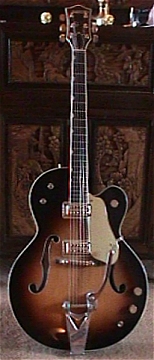 My Gretsch Country Club guitar was purchased a
few months before Sue-On and I were married in the summer of '66. The Club,
along with my first Fender Telecaster, was chosen to replace my first Gretsch,
the Chet Atkins Nashville model after it had been stolen. At this time,
I was very much into using a De Armond volume pedal for sustain to simulate
steel guitar sounds. This was a technique I had picked up after watching
Ferlin Husky's lead player use it at a Brandon Arena show a few years earlier.
My Gretsch Country Club guitar was purchased a
few months before Sue-On and I were married in the summer of '66. The Club,
along with my first Fender Telecaster, was chosen to replace my first Gretsch,
the Chet Atkins Nashville model after it had been stolen. At this time,
I was very much into using a De Armond volume pedal for sustain to simulate
steel guitar sounds. This was a technique I had picked up after watching
Ferlin Husky's lead player use it at a Brandon Arena show a few years earlier.
Also, by this time I was using what I believe
was the first ever distortion pedal: the Gibson/ Maestro Fuzz-Tone. It
was originally pitched as a brass instrument emulator, but the reaction
this wild driving sound got from audiences was nothing like that obtained
by any brass instrument. In fact, it is hard to imagine now that there
was a time when rock guitars didn't use distortion.
So, although I used both guitars at every gig,
I found that the bite of the Tele was more appropriate for the style I
was developing and I used the Gretsch less and less. Then, when my original
Gretsch was recovered, the Country Club was left at home, to be brought
out for the occasional special function, practise or television show.
It is really quite a gorgeous instrument and
I always thought it would be an ideal jazz or big band instrument if the
opportunity ever came along for me to play in such a band. My only regret
with the instrument is that, to cut costs, I had ordered a chrome Bigsby
rather than the brass model. All the other fittings on this sunburst guitar
are brass, so the Bigsby isn't a good match. This showpiece seems to be
a close cousin to the very much in demand, thick bodied 6120 and deserves
to be played much more than it is . . . O well . . . someday . . . .
Hillman Guitar No.
5
FENDER TELECASTER
Serial No. 125357
www.hillmanweb.com/guitars/g05.html
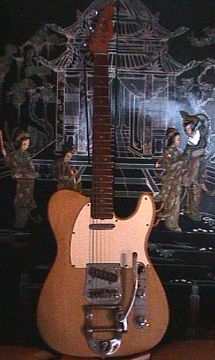 The
temporary loss of my Gretsch ushered in a Fender era. I previously had
used my dad's Marshall Wells Hardware business letterhead to obtain quite
a number of wholesale catalogues from music distributors. I had ordered
a number of Fender ampfliers, but had always been fascinated by the Telecaster.
Years earlier I had briefly played one backstage at a Johnny Cash show
when I had an impromptu lesson from the originator of the famous Tennessee
Two muted "chunk chunk" sound that they used on their Sun and Columbia
recordings. While other fans were milling around the "man in black," I
was huddled on the side of the stage where Luther Perkins patiently coached
me in his unique style while I nervously fingered his guitar. It was quite
a thrill at the time and the experience had obviously left an impression.
My ensuing call to the West Coast distributor resulted in finding a special
on a custom colour charcoal green Telecaster which my parents generously
purchased for me. I immediately fell in love with the feel and sound of
the instrument.
The
temporary loss of my Gretsch ushered in a Fender era. I previously had
used my dad's Marshall Wells Hardware business letterhead to obtain quite
a number of wholesale catalogues from music distributors. I had ordered
a number of Fender ampfliers, but had always been fascinated by the Telecaster.
Years earlier I had briefly played one backstage at a Johnny Cash show
when I had an impromptu lesson from the originator of the famous Tennessee
Two muted "chunk chunk" sound that they used on their Sun and Columbia
recordings. While other fans were milling around the "man in black," I
was huddled on the side of the stage where Luther Perkins patiently coached
me in his unique style while I nervously fingered his guitar. It was quite
a thrill at the time and the experience had obviously left an impression.
My ensuing call to the West Coast distributor resulted in finding a special
on a custom colour charcoal green Telecaster which my parents generously
purchased for me. I immediately fell in love with the feel and sound of
the instrument.
Sometime earlier I had bought a Fender Super
Reverb Amp but had nothing but trouble with its four 10-inch speakers so
I soon replaced it with what proved to be a more powerful and durable Fender
Twin Reverb. Pursuing my love of the sound of the pedal steel guitar I
later bought a Bigsby kit made for the Tele and then put on a home made
b-bender - a rather original design improvised from cup hook hinges and
a welding rod. Soon after this I added an Echocord tape delay unit and
a Fender tone/volume pedal. I also had been using a Gibson/Maestro
Fuzz-Tone distortion pedal and a Vox Wah-Wah for quite sometime.
The bite of the Tele was perfect for cutting
through many of the outdoor shows and pub dates that Sue-On and I had started
performing and gradually the Gretsches spent more time at home as the Fender
took over. The Telecaster was also an excellent recording, TV and radio
studio guitar and I used it exclusively on our first five albums and most
of our TV shows.
The original colour of the Tele is shown on
the cover of our second album but after many years of road wear and outdoor
shows it developed unsightly frost and heat cracks in the finish . . .
and was badly chipped all over. So sometime in the mid-'70s I stripped
it down to its natural wood colour. That's the way it appears on cover
of Album Volume 12. The homemade b-bender bar attached to the head and
running parallel to the neck is also visible in both photos.
This Tele was a real workhorse and served us
well until Sue-On presented me with a new Tele Thinline with Humbucker
pickups on Xmas '75. This was to be the guitar we would use on our three
tours of England and in our recording sessions in London, Newcastle and
Durham.
Hillman Guitar
No. 6
Vox Tempest XII V230
Electric 12-String
Serial No. 300068
www.hillmanweb.com/guitars/g06.html
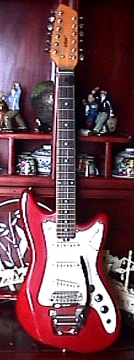 I
had been a great fan of music from England since the '50s. Some of the
first albums I had laboured over in my quest to unravel the mysteries of
guitar were Lonnie
Donegan recordings. In fact this was were I had learned my first
blues riffs. Donegan was the leading exponent of British Skiffle music
to which most of the musicians of the "British Invasion" period - including
the Beatles - acknowledge
as a major influence in getting them interested in playing in bands. Donegan
had, in turn, developed his style by playing banjo in
Chris Barber's
trad (dixieland) jazz band through which he gradually spun off a solo career
singing American black folk and blues songs. He pored over all the old
American records he could find. adapting the material to his style, and
soon found himself in the forefront of the Skiffle craze.
I
had been a great fan of music from England since the '50s. Some of the
first albums I had laboured over in my quest to unravel the mysteries of
guitar were Lonnie
Donegan recordings. In fact this was were I had learned my first
blues riffs. Donegan was the leading exponent of British Skiffle music
to which most of the musicians of the "British Invasion" period - including
the Beatles - acknowledge
as a major influence in getting them interested in playing in bands. Donegan
had, in turn, developed his style by playing banjo in
Chris Barber's
trad (dixieland) jazz band through which he gradually spun off a solo career
singing American black folk and blues songs. He pored over all the old
American records he could find. adapting the material to his style, and
soon found himself in the forefront of the Skiffle craze.
While tracking down all the Lonnie Donegan
records I could find, either in obscure record shops or through importing,
I soon came in contact with records by Cliff Richard and the Shadows.
My earliest influences then, included blues and folk via an English skiffle
group, and guitar instrumentals via the backup band to England's Elvis.
I was primed and ready then for the '60s invasion of the Beatles, Stones,
Animals, et al.
This in turn, led to a fascination with Vox
amps and guitars as they always seemed present whenever these bands made
TV or photo appearances. The first Vox purchase I made was a Wah Wah Pedal
which I added to my chain of effects devices. My second experience with
Vox followed soon after when I used a borrowed Vox amp for a teen dance
at the Shilo Army base. I wasn't too impressed with this particular model
as it overheated so much I was afraid it would blow up. It made me appreciate
my trusty Fender Twin Reverb all the more. I was still intrigued with the
very unusual Vox guitars, however.
The Brandon Musical Store in downtown Brandon
had always been a favourite place to visit. They sold guitars and amps
and records: my first LP, ELVIS, came from there as well as my second
amp, a Harmony. Sadly, all good things come to an end, and it was while
perusing their stock during their sell-out sale that I came across a Vox
electric 12-string complete with tremolo bar and string damper (mmm...
why? on a 12-string). The fact that I had never played a 12 string made
this red beauty all the more desirable . . . despite the fact that it was
in one of their more conservative Strat-style shapes.
Even though Sue-On and I were on a tight college
student enforced budget, after reporting the finding of this must-have
treasure to my beloved Nanny, she agreed that it was something I HAD to
have in my steadily growing collection of guitars. Despite the predictions
I had made that this instrument would be invaluable on stage, we found
it of limited use in our trio. It played well but it proved to be too much
of a hassle to take along and keep tuned for just a few featured numbers
on the crowded pub stages.
The Vox Tempest XII then, has remained a bit
of a curiosity piece, and has spent most of its life hanging on the wall
of our music studio, to be brought down for the occasional special occasion.
Its last sojourn from the hook was when it guested on a few tracks of The
Global Trucking Company's second CD.
Hillman Guitar No. 7
Fender Malibu Flat-Top Acoustic
Serial No. 068838
1968
www.hillmanweb.com/guitars/g07.html
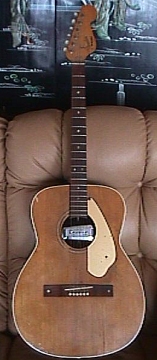 Fender
acoustic instruments have seldom impressed me. However, this palomino-coloured
gem from Fender is one of the best looking, best playing and best sounding
acoustic guitars that Fender ever made.
Fender
acoustic instruments have seldom impressed me. However, this palomino-coloured
gem from Fender is one of the best looking, best playing and best sounding
acoustic guitars that Fender ever made.
In 1968, Sue-On and I moved to Brandon for
three years to attend university. We lived with Sue-On's brother Kenny
and his wife Rebecca, in a basement suite they had just completed in their
west end home. To help pay tuition costs we played in Brandon pubs -- every
night, from Monday through Saturday -- and were up every morning for 8:30
classes. The long hours of performing necessitated the constant learning
of new material. Since we left our equipment set up in the downtown hotels
or halls: Brandon Inn's Viking Room, The Cecil, The Beaubier, The Prince
Edward, Brandon University, etc., we soon saw the need for having a good
acoustic guitar for working on material before the shows.
Enter the Fender Malibu, purchased second-hand,
with case and pickup, for $100 from Keith Dodds, a Brandon musician. Actually,
Keith now works for Leech Printing where we've had most of our album covers,
inserts and promo pics done over the years. We've always preferred to have
work like this done locally so that we have complete control over
graphics design and production and their printing offices and plant are
a stone's throw from our Brandon home. Sadly, our long relationship with
this company soured when, during a house-cleaning binge, they threw out
our entire two decade file of original artwork, family history books, design
layouts, photos, and costly colour separations. The loss has left an irretrievable
gap in the career bio that you are now reading.
This Malibu model features a unique Fender
pickup, but the type of stage work we did at the time, and the fact that
we have always worked as a trio, made it difficult to work it into our
stage sound. However, over half of the 50-odd original songs we've recorded
were written on this guitar. I also used it for acoustic rhythm tracks
on our recording sessions until I bought an Ovation Legend around the time
of the Volume 6 album. For many of the songs I replaced the three bottom
strings with treble strings for a Nashville HiBass tuning. The guitar and
its case also have the dubious distinction of being pressed into drum service
as we used them to pound out the backbeat on a few of our recorded songs.
Up until our last album I've done all of the
guitar tracks at our sessions. Usually, to get the right feel for what
we wanted and to lead the rhythm section, I would sing a rough work
track while playing a Tele. Once we had the bed tracks down -- Sue-On did
nearly all of the drums and percussion on our sessions -- I would add a
left normal acoustic track and then go back and add a hi-bass acoustic
track to the right. The stereo effect from these different acoustic sounds
sounded great in the control room, although by the time we had finished
the mix the effect was usually buried beneath the other instruments. Oh,
to re-record all of our original material using modern recording techniques
... sigh!
Hillman Guitar No. 8
FENDER THINLINE
TELECASTER
Serial No. 368950
www.hillmanweb.com/guitars/g08.html
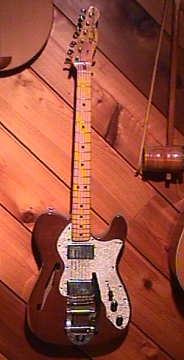 After
my grandmother's death in 1971, Sue-On took over where Nannie had left
off in trying to satisfy my addiction for guitars. On Christmas 1975, she
surprised me with a new Telecaster Thinline. She had heard me admiring
the fatter overdriving sounds that many of the current rock and blues artists
were getting, so, with a little bit of help from the staff at Brandon's
Ted Good Music store, she found one of the newer Fender Telecasters that
featured humbucker pickups. The finish was dark woodgrain and it came with
a maple fingerboard and a factory-installed Bigsby. All it was lacking
was a B-bender, and with a little help from our former rhythm player, the
very handy Jake Kroeger, we soon installed our patented rod bender and
the shiny new Tele was ready for action.
After
my grandmother's death in 1971, Sue-On took over where Nannie had left
off in trying to satisfy my addiction for guitars. On Christmas 1975, she
surprised me with a new Telecaster Thinline. She had heard me admiring
the fatter overdriving sounds that many of the current rock and blues artists
were getting, so, with a little bit of help from the staff at Brandon's
Ted Good Music store, she found one of the newer Fender Telecasters that
featured humbucker pickups. The finish was dark woodgrain and it came with
a maple fingerboard and a factory-installed Bigsby. All it was lacking
was a B-bender, and with a little help from our former rhythm player, the
very handy Jake Kroeger, we soon installed our patented rod bender and
the shiny new Tele was ready for action.
This was the guitar we took to England three
times and used on all of our English recording sessions. At the end of
June in the following summer, I arranged to leave my high school teaching
job a few days early and we flew to London to prepare for a 30 day tour
of Workingman Clubs, Discos and C&W Clubs. We packed the new Tele,
a Hohner battery-powered keyboard bass, records to sell, and our costumes.
(In our third British tour, in 1979, we added piles of diapers for toddler
Ja-On to our luggage, as we hated the strange pads that then passed for
disposable nappies in England at that time.)
We had partial sponsorship from Canada's Traynor
Amplifiers who had arranged for us to pick up our British 220-wired equipment
at Wing Music in Kent. They also supplied a good Rodgers drum kit for Sue-On.
but we couldn't find a Fender Rhodes or any other electronic piano. Our
keyboardist, Kevin Pahl, had to make do with a Hohner Clavinet (and whatever
keys that were available at each venue) and our keyboard bass for the entire
tour. Luckily, our old friend Alan Jones, who had arranged much of the
tour during one of his visits back home to England, was able to fill in
on organ in some of the clubs which had a house organ. I carried this guitar
all over the UK . . . wouldn’t let it out of my sight. I still have many
memories of struggling with our 1 ½ year old son Ja-On strapped
to my back, a suitcase in each hand, and the Tele case wedged under my
arm, while pushing our way through the London Underground passageways and
onto subway cars during rush hour. Needless to say, these odd foreigners
with the strange Canuckian accents and bearing mountains of luggage weren't
overly popular among the fellow commuters.
As suggested by the photos in our photo galleries,
this guitar proved to be a good all-around instrument. The late '70s and
early '80s were probably our busiest and most prolific time. Sue-On and
I were teaching high school and Kevin was working as a flying instructor,
grain buyer and crop duster. But somehow we found time for a Grandstand
tour of US State and County Fairs, three tours of Britain, outdoor country
festivals, a tour of the North and Western Canada, tours of military bases,
and a multitude of dance dates in rinks and halls. We also produced and
recorded nine record albums and guested/produced many more for other performers,
wrote and recorded 50 original songs, worked with most of the top country
artists of the day, performed commercials, had a number of our own TV series,
made and raised babies, performed on Canadian Country Music Association
Awards presentations, appeared on Network TV and radio shows . . . and,
in 1980, won the top award from the Manitoba Association of Country Artists:
The Entertainers of the Year Award. Amps, PAs, musicians, costumes,
songs, promoters, etc., came and went . . . but the Thinline Tele was a
constant . . . Bill and Sue-On . . . and Tele : ) Thanks ole buddy
. . . and thanks Sue-On, ya give good Xmas gifts kid.
Hillman Guitar No. 9
Link II - Pedal Steel Guitar
www.hillmanweb.com/guitars/g09.html
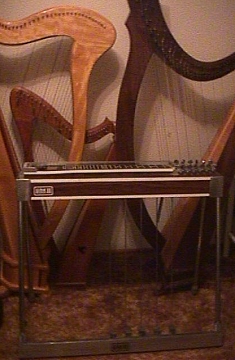
After years of building b-benders and using
Bigsbys, volume pedals and echo delay to eke out a few steel guitar sounds,
it was only natural that someday I would pick up a real steel.
This steel was manufactured in Winnipeg by
long-time steel player Wayne Link.
I then got all the manuals, a few instruction
tapes and struggled with the bar, pedals, knee levers, 12 strings and weird
tunings in my attempt to learn a few tunes like Danny Boy. But since we
were doing so much stage work . . . and since it is very hard to front
and sing with a trio while playing steel . . . I gradually drifted back
to my Tele imitations.
About this time I had also bought a Fender
Rhodes 88 electric piano to double on . . . and most stages just weren’t
big enough for all of us. The other multi-stringed instruments in our photo
galleries are our daughter China-Li's harps -- again, too many strings
for a guy so used to six strings.
Hillman Guitar No.
10
Ovation Legend 1619-4
Serial No. 049142
www.hillmanweb.com/guitars/g10.html

TALES OF THE LEGEND

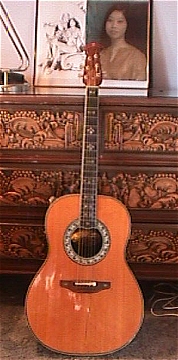 In
the mid-'70s we obtained an Ovation dealership and the sales people offered
us a good introductory special on this Ovation Legend. In many ways it
is a great guitar -- great tone and projection from its deep roundback
. . . very elaborate abalone inlays . . . fine flat-top lines . .
. a great molded case -- but over the years it has developed a few serious
flaws. The electronics are controlled by only a volume control, with no
control over tone. As a result the sound is often quite unusable without
major exterior EQ adjustment. Possibly one reason this model was sold off
so cheaply when we purchased it was that the wood wasn't properly cured.
The truss rod in the neck, for many years, had to be adjusted with each
change of season. In recent years the spruce top has developed a major
crack down the middle from the bridge to the tail pin.
In
the mid-'70s we obtained an Ovation dealership and the sales people offered
us a good introductory special on this Ovation Legend. In many ways it
is a great guitar -- great tone and projection from its deep roundback
. . . very elaborate abalone inlays . . . fine flat-top lines . .
. a great molded case -- but over the years it has developed a few serious
flaws. The electronics are controlled by only a volume control, with no
control over tone. As a result the sound is often quite unusable without
major exterior EQ adjustment. Possibly one reason this model was sold off
so cheaply when we purchased it was that the wood wasn't properly cured.
The truss rod in the neck, for many years, had to be adjusted with each
change of season. In recent years the spruce top has developed a major
crack down the middle from the bridge to the tail pin.
Despite some of these flaws, we've used it
as our main acoustic on many of our live shows, weddings, recording sessions,
etc. It was featured prominently on the cover - and sound - of our Hillman
Express ~ Track 15 ~ Vol. 6 album. Although we had almost always used
electrics for our TV work, it seemed appropriate to press the Ovation into
play for the 1980 CCMA Big Country Show at the Winnipeg Centennial Auditorium.
We were asked to do two original songs and were backed by a full orchestra.
We chose two of our singles recordings: the uptempo
Cajun Stomp
and our top ten release -- the duet ballad, One Night Stand.
The concert was quite long and featured most of the top Canadian Country
stars of the time. Appropriately, we were introduced by Nashville's
George Hamilton IV, who was familiar with us through the reputation and
trail of destruction we left along the English Workingman Club circuit
in the '70s as he worked many of the same clubs. It was a good show for
us as we were introduced as having just won the Manitoba Entertainers of
the Year Award, the crowd seemed to be with us, and we got to rub shoulders
with Canada’s top country performers on that one -- and the Ovation stayed
in tune. The tape footage was broken into two separate shows that were
shown many times on CBC network television -- shown everywhere but in our
hometown Brandon, where the programmer at the local station opted to show
a movie each time. The guys working at the station let us in to watch one
of the shows off the network feed and we have a copy on Sony U-Matic 3/4"
tape.
The producer of the CBC show seemed impressed
with our act and later called us to do a major country music gala in Toronto
in conjunction with the Grey Cup festivities. Unfortunately, it was on
short notice and we were already booked to play for a best friend's wedding
that weekend. This and the demands from my day job, teaching high school,
and caring for two-year-old Ja-On, made for a very difficult decision:
we declined. The road not taken . . . . where would it have led?
I ramble... but everytime I gaze at one of
the members of my guitar family, certain thoughts seem to flood over me
. . . these are just some of the memories that the Ovation brings back.
Many more such tales shall surface in other parts of our Musical Odyssey
pages.
Hillman Guitar No.
11
Hofner Fretless Beatle Bass
http://www.hillmanweb.com/guitars/g11.html
Hofner Memories
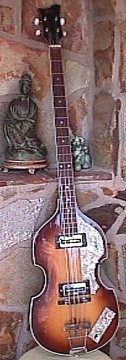 During
my first stint in college in the early '60s, my all-consuming major subject
- Music & Guitar 101 - wasn't taught in any of the lecture rooms.
True, I struggled through the History of Western Music, a Department
of Music course taught by Lorne Watson. The main attraction here was the
pass it provided to the great stereo listening rooms where we were to listen
to famous operas and the great composers. Stereo records were a relatively
new phenomenon then so night after night I would smuggle in all the stereo
LPs I could afford to buy: Elvis, Frank Sinatra, Johnny Cash, Marty Robbins,
Dave Brubeck, exotic percussion records, big bands, Nancy Wilson and other
great girl jazz & blues singers, ... and anything that sounded good
in stereo... even some of the required Classical records. Through the day
much of my time would be spent in a room down the dorm hallway where one
of my classmates, a HiFi Stereo buff, was eager to showcase his great sound
system and his great reel-to-reel tape collection of the latest Broadway
and Show tunes.
During
my first stint in college in the early '60s, my all-consuming major subject
- Music & Guitar 101 - wasn't taught in any of the lecture rooms.
True, I struggled through the History of Western Music, a Department
of Music course taught by Lorne Watson. The main attraction here was the
pass it provided to the great stereo listening rooms where we were to listen
to famous operas and the great composers. Stereo records were a relatively
new phenomenon then so night after night I would smuggle in all the stereo
LPs I could afford to buy: Elvis, Frank Sinatra, Johnny Cash, Marty Robbins,
Dave Brubeck, exotic percussion records, big bands, Nancy Wilson and other
great girl jazz & blues singers, ... and anything that sounded good
in stereo... even some of the required Classical records. Through the day
much of my time would be spent in a room down the dorm hallway where one
of my classmates, a HiFi Stereo buff, was eager to showcase his great sound
system and his great reel-to-reel tape collection of the latest Broadway
and Show tunes.
After our daily TV noon show and the occasional
class, my visits downtown would take me to the Strand Theatre for a matinee
and a browze through all the record, music, magazine book and second-hand
stores, sometimes followed by a visit to a Chinese restaurant to satisfy
a craving for my recently discovered food obsession.
A favourite music store was Johnson's Sound
on Rosser Avenue. Albert Johnson was somewhat of a musical institution
in the area. He had fronted a big band for many years, ran a dance hall
- The Palladium - next to his shop, and had starred in one of the first
live music shows on local television. In later years he designed and manufactured
Johnson guitar amps and PA systems that he exported all over the world.
I would often drop in and try out the guitars he had on display and he
would often take time to share a few of the chords and riffs he knew on
the instrument. The main line of guitars he sold were German imports: Hofners.
One of the oddest of his stock of Hofner guitars was an electric bass,
shaped like a violin. This bass wasn't a great seller... it hung there
for years. Then, the Beatles hit and suddenly it vanished from the display
window. I wish I had bought it.
A fond memory I have of the Hofner "Beatle"
bass involves Lenny Breau. I caught his act at the Establishment in Winnipeg
one night. He played the Hofner all night - solo. Amazing sounds, innovation,
technique and imagination!
Fifteen years later. Beatlemania had come and
gone -- and the popularity of the Hofner Beatle Bass had seen a sudden
rise and fall. Friend, drummer and bass player, Kerry Morris and I were
doing a lot of experimenting with a recording studio in the basement of
our Maple Grove home and we realized that the sound needed the punch from
a good bass.
Sue-On and I had been Beatles fans from the
start -- in fact, we had the thrill of playing in many of the North East
England venues that the Silver Beetles had played in their early days --
and where many of the touring musicians we worked with still carried on
the Hofner tradition. Fortunately, at about this time the monthly special
from one of our music wholesale catalogues featured a Hofner fretless bass
that the company had some trouble moving - catching dust in their warehouse
- until now. Within a week I was soon the proud owner of a Beatle
Bass.
Sorry I didn't trust in your musical know how
back then, Albert. You... and Paul McCartney . . . were ahead of your time.
Bill Hillman Guitar No.
12
YAMAHA ACOUSTIC 12-STRING
FG-512
www.hillmanweb.com/guitars/g12.html
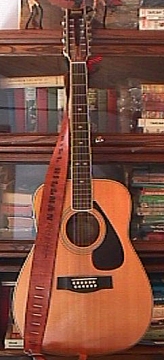
In the early '80s, Sue-On made the mistake of
putting a set of guitar strings for an acoustic 12-string in my Xmas stocking
one Christmas - bewildering as I did not own an acoustic 12-string. Our
Christmases are always a major gift-sharing event and we always save our
biggest and best surprise gifts for each other until after the stack of
little ones under the tree are opened. The early stocking gift sort of
took away from the surprise she had planned when it came time for the final
extravaganza. She gave me a card that directed me to look under our bed
for a surprise. Hidden there was a Yamaha guitar in a brown hardshell
case.
This proved to be a great guitar for many of
the folk-influenced gigs we often were called upon to do. Always on the
lookout for good duet harmony songs, our greatest influences were Ian and
Sylvia, the Everly Brothers, Peter, Paul and Mary, and many of the traditional
country and folk greats. And of course, a 12-string goes well with so much
of this material.
As with any of the Yamaha guitars I have tried,
this model shows fine craftsmanship, plays well, sounds good, and has many
more great features -- all for a very reasonable price. Up till now we
had only ever had two experiences with Yamaha instruments: first, with
one of their electric basses which Barry Forman our longtime bass/fiddle
bandmate played for many years, and second, our Yamaha Baby Grand Piano
which was, and is, a gorgeous instrument.
Hillman Guitar No.
13
ROLAND GUITAR SYNTHESIZERS
Roland G-707 & G-303 Guitar
Controllers
www.hillmanweb.com/guitars/g13.html
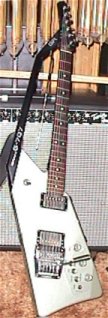
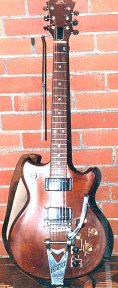 In the mid-’80s I had traded video equipment for
the earlier version of the Roland synth the G-303 -- from friend and fellow-musician
Ken Storie... but soon after I traded in this system for the "new improved"
700 series. The G-303 is the only guitar I have ever traded or sold, but
the cost of the new system (well over $4000) forced me to part with it
as a down payment. Before trading it in I removed the b-bender and Bigsby...
and re-installed the Bigsby onto my Gretsch Country Club. Ever since this
early experience with guitar synths I've had a fascination for them. I've
put some of the info on the Roland systems into the following site which
I hope will provide some reference for pickers sharing a similar interest.
In the mid-’80s I had traded video equipment for
the earlier version of the Roland synth the G-303 -- from friend and fellow-musician
Ken Storie... but soon after I traded in this system for the "new improved"
700 series. The G-303 is the only guitar I have ever traded or sold, but
the cost of the new system (well over $4000) forced me to part with it
as a down payment. Before trading it in I removed the b-bender and Bigsby...
and re-installed the Bigsby onto my Gretsch Country Club. Ever since this
early experience with guitar synths I've had a fascination for them. I've
put some of the info on the Roland systems into the following site which
I hope will provide some reference for pickers sharing a similar interest.
Hillman Guitar
No. 14
Mosrite Electric Mark XII 12-String
www.hillmanweb.com/guitars/g14.html
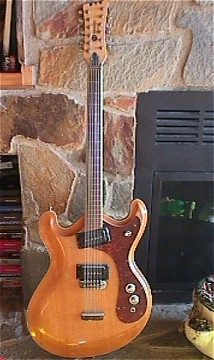 In
the middle of a trading binge in the '80s I worked out a swap with local
guitarist Doug Strange. I traded a Randall bass amp for a guitar
which had fascinated me since my "Ventures days." Most by-ear guitar players
who were trying to learn their craft in the early ‘60s were fans of this
instrumental quartet. During my Brandon University years, starting in 1961,
my noon hours were spent performing a live daily show on CKX-TV, my afternoons
were spent at the Strand Theater catching the matinee and my evenings were
devoted to jamming and rehearsing with one of the 3 or 4 bands I was playing
with at that time . . . the grades were not great.
In
the middle of a trading binge in the '80s I worked out a swap with local
guitarist Doug Strange. I traded a Randall bass amp for a guitar
which had fascinated me since my "Ventures days." Most by-ear guitar players
who were trying to learn their craft in the early ‘60s were fans of this
instrumental quartet. During my Brandon University years, starting in 1961,
my noon hours were spent performing a live daily show on CKX-TV, my afternoons
were spent at the Strand Theater catching the matinee and my evenings were
devoted to jamming and rehearsing with one of the 3 or 4 bands I was playing
with at that time . . . the grades were not great.
One of the bands I worked with was managed
by the owner of the Brandon Roller Rink who used to bring in some of the
top artists of the day. We were employed as the house band for this huge
rink located near the old Brandon Arena, which doubled as a show and dance
venue. This was a good excuse to catch and rub shoulders with every act
he brought in: Conway Twitty with Al Bruno on guitar, Elvis’s Memphis
buddies Johnny and Dorsey Burnette, Chad Allan and the Reflections
with Randy Bachman on guitar, the Fireballs . . . and the Ventures. One
of my hobbies at that time was to collect behind-the-scenes anecdotes .
. . and guitar picks from the performers . . . but the main reason for
attending was to drool over the guitar licks displayed by the full-time
professional lead guitar players.
Meeting these California guitar greats and
actually seeing them in action was one of the highlights of these early
years. When I saw the Ventures in the early '60s they played Fenders. They
had mentioned that the reason their Fender instruments weren't all featured
on their first album cover - Walk Don't Run - was that they were touring
when the photo was taken and the photo actually featured model stand-ins.
A few years later, during their boom years, as part of an endorsement deal,
they played Mosrite guitars exclusively. The unique shape of the Mosrite
supposedly came about when the designers traced the outline of a turned-over
Stratocaster.
One of the previous owners of the the Mosrite
I took possession of had strung the instrument with six strings . . . ordinarily
not that unusual a procedure, but this model was actually a 12-string guitar.
As with all Mosrites, the neck is incredibly thin and easy to play -- and
the instrument has quite a distinctive sound. It has an alder body, featuring
the "German carve" perfected by Mosrite founder Semie Moseley. The thin
maple neck is topped with a 24.5" scale rosewood fretboard and Klusons
tuners.
It has an honoured place on my guitar wall.
Hillman Guitar No.
15
Fender Stratocaster Plus
Serial No. N3146907
www.hillmanweb.com/guitars/g15.html
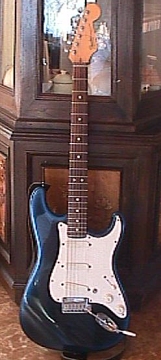 Since
its official debut in early 1954 the Fender Stratocaster has proven to
be one of the most successful, most influential and most cloned electric
guitars ever manufactured. My blue Strat was another of Sue-On’s surprise
Xmas gifts and it made our first Brandon Christmas away from our country
home a memorable one. One of my first guitar heroes was Hank Marvin of
England’s Shadows. I have always been intrigued by his red Strat, but since
Sue-On knows that blue is my favourite colour, blue is what I got.
Since
its official debut in early 1954 the Fender Stratocaster has proven to
be one of the most successful, most influential and most cloned electric
guitars ever manufactured. My blue Strat was another of Sue-On’s surprise
Xmas gifts and it made our first Brandon Christmas away from our country
home a memorable one. One of my first guitar heroes was Hank Marvin of
England’s Shadows. I have always been intrigued by his red Strat, but since
Sue-On knows that blue is my favourite colour, blue is what I got.
Back in the fifties, I was introduced to many
forms of American Blues in a very roundabout way. I became obsessed with
the skiffle music of LonnieDonegan
and set up many pipelines through which I could import his records (See
our Lonnie Donegan Discography here). It was only later that I fully
grasped the debt he owed to American Blues artists and that many of the
guitar riffs I had learned from his records were actually this Brit's version
of the blues. (Ten years later a whole new generation of guitarists
would go through a similar experience when they would be introduced to
the Blues by the Beatles, Stones, Animals, Cream, etc. - interestingly,
most of the guitarists in these groups had been influenced by the music
of Lonnie Donegan).
I expanded upon these contacts I had made in
England and was soon importing the records of Cliff Richard - England’s
'Elvis.' This led me into the world of the Shadows,
Cliff’s backup group, featuring bespeckled Hank Marvin. Since there was
a tremendous demand for instrumentals in the groups I worked with, the
sounds created by Hank's Strat were soon being imitated by a red-haired,
black-hornrimmed, Gretsch playing Canadian. It was to be thirty years before
I could try out these songs on a Strat.
My first experience with playing a Strat was
not an auspicious one. We were booked for an arena dance at the Oak River
Dance Gardens just after my Gretsch had just been stolen. I took along
my Silvertone but my rhythm player offered to swap his Strat for the evening.
Soon into the performance however, I realized that I was so used to the
feel of the Gretsch with its saddle bridge and its well-positioned Bigsby
lever that I could palm, that I just couldn't get used to the Strat. The
whammy bar kept dropping out of reach and my combined picking/strumming
technique constantly turned down the volume control by accident. I finished
the evening playing trusty ole Sears Silvertone.
As the years passed by, however, many more
of the guitars players I admired, and often imitated, showed a preference
for the Strat: Clapton, Mark Knopfler, Ventures,
Vince Gill, Stevie Ray Vaughn, Robert Cray, Buddy Guy, Bonnie Raitt, etc.
In fact, seldom do you see any sort of popular band that doesn't feature
a Stratocaster or Gibson Les Paul.
Thanks for the present, kid . . . it's a classic.
Hillman Guitar No. 16
Gibson CF-100 Acoustic
4120 21
www.hillmanweb.com/guitars/g16.html
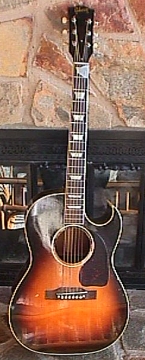
Sue-On has always allowed, and even encouraged,
me to indulge in what often turn out to be expensive pursuits in the name
of music.
Despite my appreciation of guitars, I made
it almost into the 21st century without ever owning, or even playing, a
Gibson instrument.
Strange, as so many of my favourite players
and so much of the music I've listened to are associated with Gibson guitars.
So, when the opportunity came up to buy a Gibson
acoustic from a one-time local jazz player who had retired from the music
scene, my ever-supportive mate encouraged me to go through with the purchase.
The guitar is in good shape, has good tone
and is easy to play. I've never taken it on stage but I did use it in a
TV
documentary that the CBC did on us in 1996. They wanted to show us
making music at home at Maple Grove before they taped one of our stage
performances at Clear Lake resort. We sang a duet, while Sue-On played
our Yamaha grand piano and I strummed on the Gibson.
Bill Hillman Guitar No.
17
Yamaha Black Jumbo
Electro-Acoustic FJ681
Serial No. 40517538
www.hillmanweb.com/guitars/g17.html
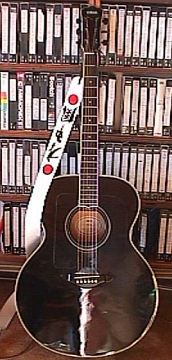
Ever since working with the Everly Brothers in
the early '60s I have been a devoted fan of their harmonies . . . and their
black Gibson guitars. Since buying a vintage Everly guitar was out of my
price range, I recently did the next best thing a few years ago — I answered
an add placed by a pensioner and former-jazz-player and bought his sunburst
Gibson acoustic, but it really didn't look or feel much like an Everly.
So, soon after this purchase I ordered a Yamaha black jumbo which looked
much like an Everly Gibson -- sort of a poor man's Everly model.
I have used this easy-to-amplify acoustic for most of our recent small
gigs where we perform without the full band line-up.
We have done a number of folk festivals and
ethnic concerts in recent years where it has been a treat to work with
our kids. First-born, Ja-On has played sax in rock bands and he has taught
the instrument at a local music studio. Son, Robin, besides playing trombone
in the Brandon University Jazz Band as well as drums and bass on many of
our stage shows, also has a keen interest in Celtic music and looks forward
to playing bodhran drums on our acoustic shows. Daughter China-Li, drawing
from her Scottish roots, is an even more avid student of all things Celtic.
Besides playing piano, synths, drums, guitar, trombone -- she is an excellent
harpist and bagpipe player, and highland dancer. Her musical talents have
been on hold in recent years as all of her energies have gone into obtaining
an MD degree and then going on to specialize in Radiology.
The booming sound of my Yamaha acoustic seems
to fit in quite nicely with our Celtic explorations. In keeping with my
appreciation of all things Chinese, as well as Celtic, I offset the shiny
black finish of this flat-top by adding a white strap decorated with Asian
characters.
Interestingly, a guitar similar to this one
was used by Randy Bachman, much of the time, on their re-union tours and
TV specials.
Bill Hillman Guitar No.
18
Yamaha APX6
Acoustic/Electric Guitar
No. 20815721A
www.hillmanweb.com/guitars/g18.html
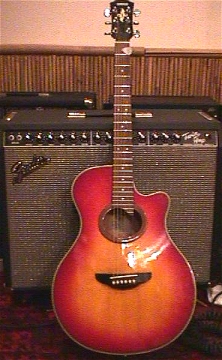
Not much to say about this guitar . . . it's proven
to be a real workhorse.
It spent some of its first years hanging on
the wall behind the stage in our SOO'S Restaurant Showhall. We reserved
this electric-acoustic for visiting musicians to use during our Saturday
Night Jam Sessions.
Since most guitarists/singers brought their
own instruments, this guitar was only occasionally pressed into service.
When I was recruited by Brandon University
to teach in the Faculty Eduation as Assistant Professor I moved this guitar
into my BU office. It proved to be a useful tool for putting variety into
my classes . . . as well as for a few after-class jams with students.
When I retired from University after a 40-year
career as an educator, the guitar was passed on to our grandson, Soulin,
who showed an interest in learning the instrument.
Bill Hillman Guitar
No. 19
Roland G-202 Guitar Synth
No. 20815721A
www.hillmanweb.com/guitars/g19.html
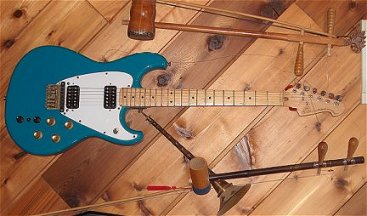 This synth guitar, along with the companion GR-300
synth were added to my guitar armada in 2003.
This synth guitar, along with the companion GR-300
synth were added to my guitar armada in 2003.
Both units had languished, unsold and forgotten
- with original price stickers still displayed - in a Ted Good Music (Brandon)
storage room since the 1980s. They looked lonely -- I brought them home
with me.
The early Roland synth guitars have a distinguished
history. I feel fortunate to be the owner -- and player -- of three of
these instruments. Much of the research I've done on the series is featured
in the companion guitar pages I've created.
Bill Hillman Guitar No. 20
Fender Telecaster
J5
No. MSN621194
www.hillmanweb.com/guitars/g20.html
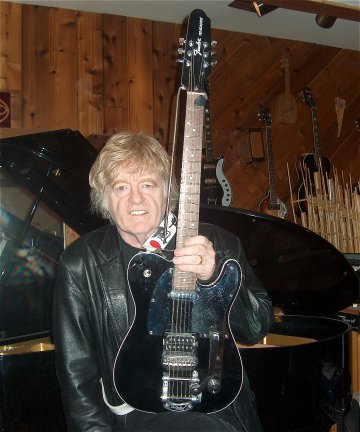
I purchased this beaut in the summer of 2005.
The Tele J5 signature model
-- co-designed by guitar whiz John 5
-- was a "gotta have" instrument that I needed to
round out my arsenal of Teles. The hot pickups, special features and very
unusual headstock design piqued my interest as soon as I came across it
in the new Fender catalogue.
The price of the Fender Custom Shop model with
Bigsby was prohibitive, however.
My solution was to order the much more affordable
Mexican-made model sans Bigsby and to install a designed-for-Tele Bigsby
I had bought earlier on e-Bay. Unfortunately, this Bigsby kit was designed
for the standard Tele pup layout, but with the help of friend Jim Ghidoni
we did some drastic metal cutting in his hot rod custom shop and adapted
stock Tele Bigsby plate to fit over the J-5 bridge pickups.
While at it we installed my patented B-bender
rod to the headstock.
This is indeed a custom model - I've done modifications
to this very expensive instrument that would make most guitar aficionados
shudder : ) But it's a hot guitar and is fun to play and sees regular service
at our weekly Cantina jam sessions.
Hillman Guitar No. 21
THE ROLAND G-77 BASS GUITAR
WITH GR-77B SYNTHESIZER
Plus
SUE-ON'S VINTAGE SYNTHS &
KEYS
www.hillmanweb.com/guitars/g21.html
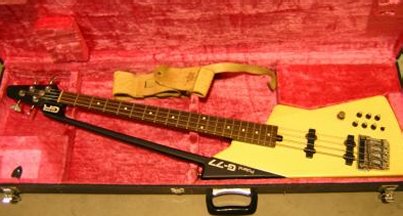
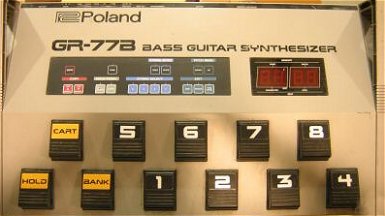
I've been a longtime fan of the Roland synth guitars, so when an old
G-77 Bass system -- 1985 guitar controller and floor synth -- appeared
for a great price on e-Bay, this +20-year-old vintage synthesizer system
was a "must have."
This seemed to make a lot of sense since I had only one bass -- a
Hofner Beatle Bass -- and I was reluctant to take it on the road. Over
the decades the various 3rd members of our trio often played bass: Barry
Forman (Yamaha), Kevin Pahl (numerous keyboard basses), Kerry Morris (Fender),
son Robin (Fender). . . and Sue-On, when not playing drums, played a series
of keyboard basses (see below: Hohner, Fender, Moog, Roland).
We've used the Roland Bass Synth numerous times without the synth
floor module at our weekly Cantina jam sessions. It plays well.
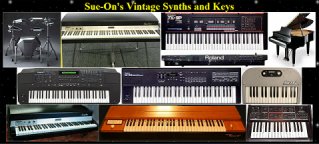
Bill Hillman Guitar No.
22
Gretsch Americana Wild West
Sweethearts
(Actually part of Sue-On's collection of
the four Gretsch Americana Guitars)
Model No. G4530 ~ Serial No. 10-07010933
www.hillmanweb.com/guitars/g22.html
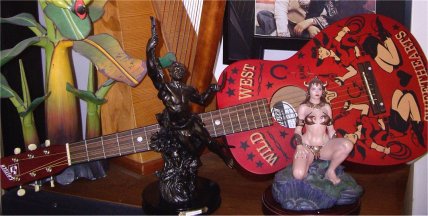
The limited-edition G4530 Wild West Sweethearts guitar is the first
installment in the Gretsch Americana Series. Reminiscent of the ol' cowboy
guitars of yesteryear, this acoustic steel-string guitar features distinctive
looks, original Western-inspired artwork, and playability.
The short-scale length, 3/4-size design, durable real-wood construction
and a precise factory setup make the Wild West Sweethearts a great
portable acoustic - perfect for sing-alongs around the campfire.
The Sweethearts travelled the wild west with
us all the way down to their California High Desert Eden retreat near Joshua
Tree and Yucca Valley during our 2012 visit with author Robin Maxwell and
Max Thomas. We all visited nearby Pioneer Town, where so many Roy Rogers
and Gene Autry films were made. . . it fit right in.
Bill Hillman Guitar No.
23
Gibson Acoustic Guitar
L Series
Age and Serial Number not known
www.hillmanweb.com/guitars/g23.html
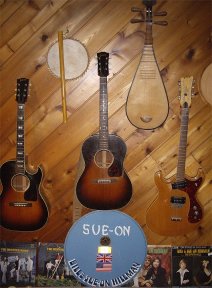
I've had trouble identifying this model. It was purchased by Brandon
University professor,
Dr.
Robert Brockway, in an American pawnshop/second hand store in the early
'50s. It was pretty beat up at that time and was in even worse shape when
I inherited it as a gift from Katy Brockway in my last year as a professor
at BU.
The finish on the back of the guitar was in poor condition but there
were no cracks in the wood, the neck was straight, and it appeared to sound
very good. I decided to invest some time and money into it to bring it
back to playing condition.
Other than to clean it up I didn't do anything with the finish, but
I replaced the frets, the tuning keys, the bridge pegs and strings. It
now sounds better than most acoustics I've played.
The guitar has ladder bracing, binding on top and back, is about
14 1/2" wide, and there is no evidence of a serial number. There is a curious
plate on the head with the name "GENE".
Bill Hillman Guitar
No. 24
Humphrey Antique Acoustic Guitar
Age and Serial Number not known
Over 100 years old ~ Inherited Guitar
www.hillmanweb.com/guitars/g24.html
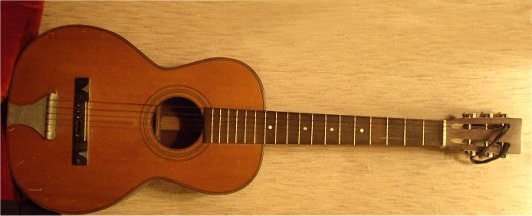
Bill Hillman Guitar No.
25
Gretsch Americana Sundown Serenade
Model No. G4500 ~ Serial No. 10-07050819
www.hillmanweb.com/guitars/g25.html
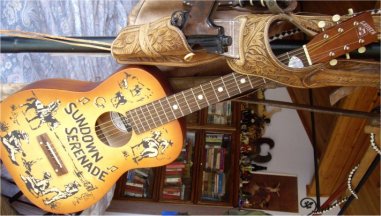
Bill Hillman Guitar No. 26
Gretsch Americana
Showdown
Model No. G4510 ~ Serial No. 10-07030057
www.hillmanweb.com/guitars/g26.html
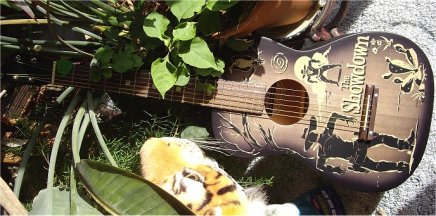
Bill Hillman Guitar No.
27
Gretsch Americana Way Out
West!
Model No. ~ Serial No. 10-070
www.hillmanweb.com/guitars/g27.html
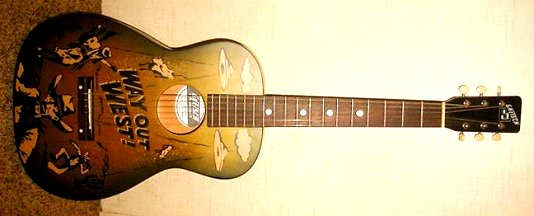
Bill Hillman Guitar No.
28
Gretsch Pro Jet
Series: Electromatic Collection
Serial No. CYG10010431
The Saga of the Gretsch Electromatric Pro-Jet
by Sue-On
www.hillmanweb.com/guitars/g28.html
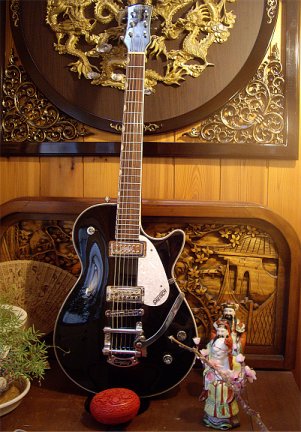
December 2010, Bill and I made a deal to just order a pile of books
and CDs from Amazon as our joint Christmas present to each other. The boxes
arrived and sat under the most perfectly shaped and newly decorated Christmas
tree. The boxes looked boring and held no real surprises, so what to do?
As I have for many, many years since our marriage, I’ve always turned
to Ted Good Music for inspiration: 12-string guitar (good for another story),
a Telecaster, a Stratocaster, various effects pedals, guitar straps, etc.
Bill had mentioned one evening a while back that he'd like to get
a pick-up for his Gibson acoustic guitars one of the days. With that in
mind, I slipped away one afternoon to the music store. The guys always
smile when I go in - knowing this was my annual Christmas run. Scott showed
me a very nice stand-alone pick-up: + $300.00. He went away to look for
another model, slightly cheaper.
While waiting, I saw this "very pretty”"black shiny guitar, saw a
"SALE PRICE" tag and couldn't resist having a look. It was a Gretsch. Now,
I don’t know much about guitars even though I've been surrounded by them
for the last 45 years, but I do know the name stood for quality. I mean,
I made Bill buy 3 Americana collection acoustic Gretsch guitars (for me)
even though they had cowboys painted on them!
After being assured as to the guitar's playability, and thinking
that it was only $300.00 more than the pick-up, I knew this would be the
best stocking stuffer for Bill! Scott threw in a Gretsch baseball
cap autographed by Chet Atkins -- another perfect "stocking stuffer". I
added the guitar case as well. These were to stay at the store until I
could sneak them into the house.
With our kids installed in the basement bedroom, it was the perfect
place to hide the surprise. Christmas morning, after Santa filled the stockings,
we woke up to see what he'd left behind. Bill was quite intrigued by the
cap and wondered where I found it! Then one of the kids brought up the
real surprise. Bill was quite speechless! It was well worth the extra money
;-) It seems I made a good choice and remain the perfect wife!
Bill Hillman Guitar No. 29
Epiphone SG
Special
Serial No. 311544942
Plus Sue-On's trusty Ludwigs
www.hillmanweb.com/guitars/g29.html
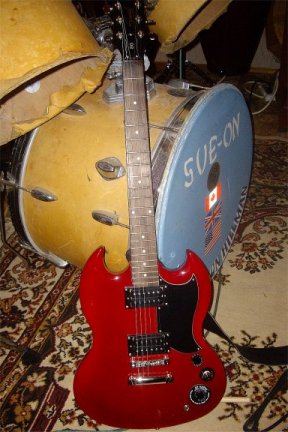
I had this guitar in hand for only about a month.
. . it is still within reach . . . and I see it/play it every week : )
My grandson, Soulin, comes over for guitar
lessons, and my Fender Strat was always a favourite. That is, until I showed
him a photo of a red SG in a rock book. "Wow! That's a cool guitar!"
So, when a red SG appeared on eBay for a great
price, we made a successful bid. The beaut arrived a month before Xmas
. . . and then Santa got his hands on it. Not a bad starter guitar . .
. a far cry from my Harmony Monteray of over 50 years ago.
While visiting for his guitar lessons Soulin
gets a kick out of playing Grandma Sue-On's Ludwig drums. These drums
are a true survivor having travelled many a mile since the '60s. They even
survived a disastrous stage fire . . . after which I sanded off the char
and covered them with buckskin. They look a little weary, but still sound
great. . . the buckskin seems to give them a unique sound :)
Sue-On's Ludwig drums have served us well for
almost 50 years. There has been a long line of replacement heads and hardware,
but the basic drums have survived countless gigs across Canada and the
US (they refused to fly overseas with us to our English tours). They've
suffered temperature extremes of -40 to +40 degrees. The outdoor
shows were tough on them: rodeos, US grandstand shows, street dances, car
shows, fairs, parades, outdoor PowWows on Reserves, Treflan demos in farmers'
fields, etc. -- in which they had to put up with rain, hail, snow, dust,
wind, flies and mosquitoes, heat, cold, blistering sun, bouncing flatbeds
pulled by crazy tipsy drivers . . . and fire! See the Saga of the Flaming
Drums at: www.hillmanweb.com/h400.html
Yes, they are a bit weary and now rest most
of the time in our home studio -- but are still road- and stage-worthy,
and still follow Sue-On to gigs for which our son Robin, or other guest
drummers aren't available.
Bill Hillman Guitar No.
30
Epiphone Gibson Les Paul
Serial No. 101032411
www.hillmanweb.com/guitars/g30.html
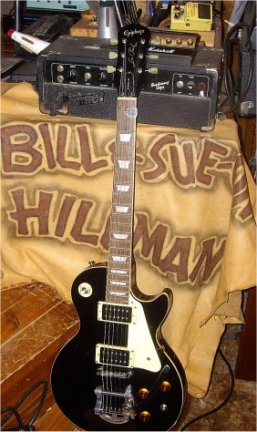
This Christmas guitar giving must stop!
Sue-On did it again on Xmas 2011 . . . she
even added a gutsy little 20 watt Fender Mustang I amp. Gibson Les Pauls
have always evaded my grasp, but here's the next best thing - the Epiphone
model. . . with Bigsby.
We met the legendary Les Paul (June 9, 1915-August
13, 2009) after his show at Broadway's Iridium Jazz Club, NYC, back in
May 2006 ~ www.erbzine.com/mag16/1673a.html
It was a thrill to finally meet Les Paul --
the 91-year-old guitar and tech legend -- at his regular Monday night performance
in this intimate Broadway club.
We caught Les's reaction on camera when he
learned I that I play a Fender Telecaster.
Our table mate Nathan's young son had the foresight
to bring a pick-guard from his Gibson Les Paul guitar which Les autographed
for him.
This was almost six years before I finally
added this Les Paul guitar to my guitar wall.





 My
Silvertone guitar was a constant companion during my first year at Brandon
College, so word started to get around that I was some kind of guitar player.
Gradually I started jamming with other musicians and bands: folk, jazz,
rock, country, etc. One of the bands had a TV show, but had experienced
a bit of a breakup. A classmate in the college dorm, fiddler Barry
Forman, had kept the rights to the band name - the Country Gentlemen
- as well as the contracts that went with it. Before long, Barry and I
were rushing from morning classes every day to reach the CKX-TV studios
in time for a daily TV noon show. [See
The Country Gentlemen Years] I was expecting to play rhythm guitar
on this largely unrehearsed show but on the first day found myself doing
lead guitar solos. It was time for a more professional guitar.
My
Silvertone guitar was a constant companion during my first year at Brandon
College, so word started to get around that I was some kind of guitar player.
Gradually I started jamming with other musicians and bands: folk, jazz,
rock, country, etc. One of the bands had a TV show, but had experienced
a bit of a breakup. A classmate in the college dorm, fiddler Barry
Forman, had kept the rights to the band name - the Country Gentlemen
- as well as the contracts that went with it. Before long, Barry and I
were rushing from morning classes every day to reach the CKX-TV studios
in time for a daily TV noon show. [See
The Country Gentlemen Years] I was expecting to play rhythm guitar
on this largely unrehearsed show but on the first day found myself doing
lead guitar solos. It was time for a more professional guitar.

 The
temporary loss of my Gretsch ushered in a Fender era. I previously had
used my dad's Marshall Wells Hardware business letterhead to obtain quite
a number of wholesale catalogues from music distributors. I had ordered
a number of Fender ampfliers, but had always been fascinated by the Telecaster.
Years earlier I had briefly played one backstage at a Johnny Cash show
when I had an impromptu lesson from the originator of the famous Tennessee
Two muted "chunk chunk" sound that they used on their Sun and Columbia
recordings. While other fans were milling around the "man in black," I
was huddled on the side of the stage where Luther Perkins patiently coached
me in his unique style while I nervously fingered his guitar. It was quite
a thrill at the time and the experience had obviously left an impression.
My ensuing call to the West Coast distributor resulted in finding a special
on a custom colour charcoal green Telecaster which my parents generously
purchased for me. I immediately fell in love with the feel and sound of
the instrument.
The
temporary loss of my Gretsch ushered in a Fender era. I previously had
used my dad's Marshall Wells Hardware business letterhead to obtain quite
a number of wholesale catalogues from music distributors. I had ordered
a number of Fender ampfliers, but had always been fascinated by the Telecaster.
Years earlier I had briefly played one backstage at a Johnny Cash show
when I had an impromptu lesson from the originator of the famous Tennessee
Two muted "chunk chunk" sound that they used on their Sun and Columbia
recordings. While other fans were milling around the "man in black," I
was huddled on the side of the stage where Luther Perkins patiently coached
me in his unique style while I nervously fingered his guitar. It was quite
a thrill at the time and the experience had obviously left an impression.
My ensuing call to the West Coast distributor resulted in finding a special
on a custom colour charcoal green Telecaster which my parents generously
purchased for me. I immediately fell in love with the feel and sound of
the instrument.

 Fender
acoustic instruments have seldom impressed me. However, this palomino-coloured
gem from Fender is one of the best looking, best playing and best sounding
acoustic guitars that Fender ever made.
Fender
acoustic instruments have seldom impressed me. However, this palomino-coloured
gem from Fender is one of the best looking, best playing and best sounding
acoustic guitars that Fender ever made.
 After
my grandmother's death in 1971, Sue-On took over where Nannie had left
off in trying to satisfy my addiction for guitars. On Christmas 1975, she
surprised me with a new Telecaster Thinline. She had heard me admiring
the fatter overdriving sounds that many of the current rock and blues artists
were getting, so, with a little bit of help from the staff at Brandon's
Ted Good Music store, she found one of the newer Fender Telecasters that
featured humbucker pickups. The finish was dark woodgrain and it came with
a maple fingerboard and a factory-installed Bigsby. All it was lacking
was a B-bender, and with a little help from our former rhythm player, the
very handy Jake Kroeger, we soon installed our patented rod bender and
the shiny new Tele was ready for action.
After
my grandmother's death in 1971, Sue-On took over where Nannie had left
off in trying to satisfy my addiction for guitars. On Christmas 1975, she
surprised me with a new Telecaster Thinline. She had heard me admiring
the fatter overdriving sounds that many of the current rock and blues artists
were getting, so, with a little bit of help from the staff at Brandon's
Ted Good Music store, she found one of the newer Fender Telecasters that
featured humbucker pickups. The finish was dark woodgrain and it came with
a maple fingerboard and a factory-installed Bigsby. All it was lacking
was a B-bender, and with a little help from our former rhythm player, the
very handy Jake Kroeger, we soon installed our patented rod bender and
the shiny new Tele was ready for action.


 During
my first stint in college in the early '60s, my all-consuming major subject
- Music & Guitar 101 - wasn't taught in any of the lecture rooms.
True, I struggled through the History of Western Music, a Department
of Music course taught by Lorne Watson. The main attraction here was the
pass it provided to the great stereo listening rooms where we were to listen
to famous operas and the great composers. Stereo records were a relatively
new phenomenon then so night after night I would smuggle in all the stereo
LPs I could afford to buy: Elvis, Frank Sinatra, Johnny Cash, Marty Robbins,
Dave Brubeck, exotic percussion records, big bands, Nancy Wilson and other
great girl jazz & blues singers, ... and anything that sounded good
in stereo... even some of the required Classical records. Through the day
much of my time would be spent in a room down the dorm hallway where one
of my classmates, a HiFi Stereo buff, was eager to showcase his great sound
system and his great reel-to-reel tape collection of the latest Broadway
and Show tunes.
During
my first stint in college in the early '60s, my all-consuming major subject
- Music & Guitar 101 - wasn't taught in any of the lecture rooms.
True, I struggled through the History of Western Music, a Department
of Music course taught by Lorne Watson. The main attraction here was the
pass it provided to the great stereo listening rooms where we were to listen
to famous operas and the great composers. Stereo records were a relatively
new phenomenon then so night after night I would smuggle in all the stereo
LPs I could afford to buy: Elvis, Frank Sinatra, Johnny Cash, Marty Robbins,
Dave Brubeck, exotic percussion records, big bands, Nancy Wilson and other
great girl jazz & blues singers, ... and anything that sounded good
in stereo... even some of the required Classical records. Through the day
much of my time would be spent in a room down the dorm hallway where one
of my classmates, a HiFi Stereo buff, was eager to showcase his great sound
system and his great reel-to-reel tape collection of the latest Broadway
and Show tunes.






















